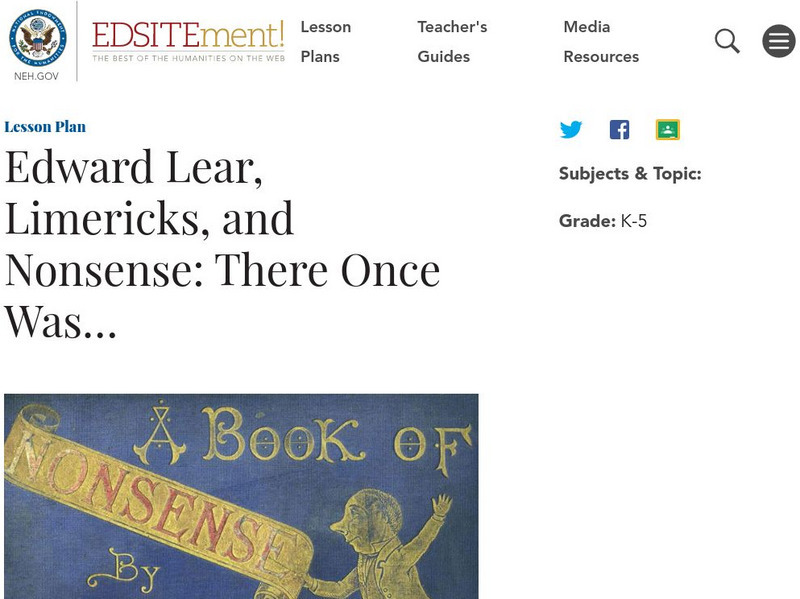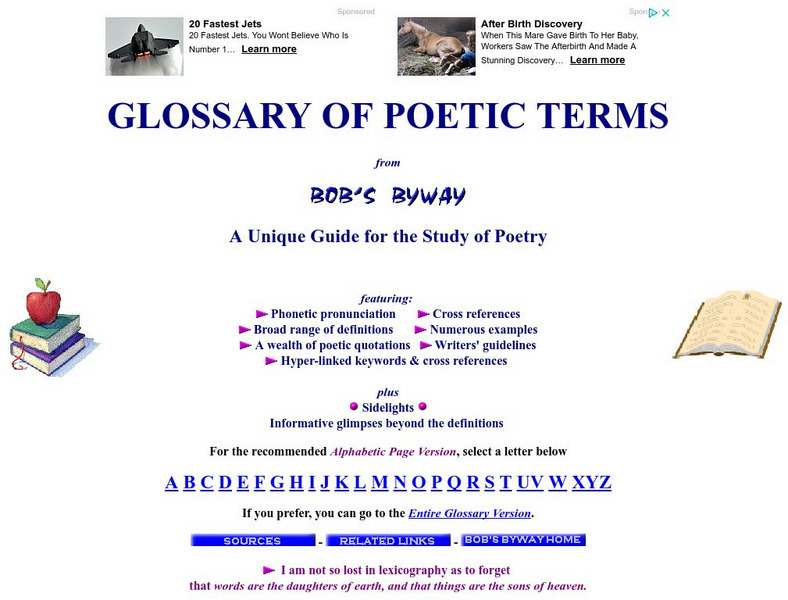Hi, what do you want to do?
Curated OER
Figurative Language Scavenger Hunt
Eighth graders analyze and interpret figurative language. They listen to some examples of poetry which use figurative language. Then, they divide into groups and attempt to find more examples. Finally, 8th graders write what the poet is...
Curated OER
Those Cells Look Good Enough to Eat
Students explore the parts of the cell. In this cell lesson plan, students use foods to create cell models that represent the nucleus, cytoplasm, cell membrane, mitochondria, ribosomes, vacuoles, endoplasmic reticulum, and Golgi bodies...
Curated OER
Patterns in Poetry: Part 2 -- Sound
Students understand a variety of poems listening for sound letter correspondence, rhyme scheme, assonance, and alliteration. In this language arts lesson, students practice listening and reading skills to complete patterns in...
Curated OER
Stylistic Devices
Young scholars review connotation and denotation and stylistic devices in poetry. They read the lyrics to a song as it is being played and then discuss the meaning of the song. As a class, students read poems, share their thoughts, and...
Curated OER
Reading, Writing, Reciting Exciting Poetry!
Students complete a poetry analysis unit. In this poetry analysis lesson, students study poetry by reading, reciting, and analyzing poems and their poets. Students study poetic devices, write their own poems, and complete hands-on...
Curated OER
Georgia Performance Standards Framework for ELA Unit 6-8th grade
Eighth graders explore figurative language through the study of picture books. In this figurative language lesson plan, 8th graders listen to books and chart the figurative language that they hear. Students discuss examples in groups.
Curated OER
Bringing the Line to Life
Young scholars use different types and lengths of sentences. They write with an insight of the stylistic aspects of composition. Students use precise language including adjectives, adverbs, action verbs and specific details that convey...
Curated OER
Modern American Poetry
Pupils identify different types of literary terms in poems. They read different poems and create a packet summarizing them. They write a poem of their own and a biography of one of their favorite poets.
Curated OER
Newspaper Writing in Various Genres
In this newspaper writing in various genres worksheet, students create 8 newspaper articles in different genres (list provided), following the examples given, with grading rubric included.
Curated OER
Teaching "A Week in the Woods"
The book, A Week in the Woods is the focus of the very interesting language arts instructional activity presented here. After the book has been read, learners engage in study of certain parts of the book in order to gain a better...
Curated OER
Poetry Unit Test
In this poetry worksheet, students complete multiple choice questions on different aspects of poetry. Students complete 40 questions total.
Curated OER
Connecting Poetry with Philanthropy
Learners examine the different types of poetic conventions. They write a poem about philanthropy using these conventions. They illustrate their poem with artwork of their choice.
Other
Centre for Literacy in Primary Education: Poetryline: Poetic Forms and Devices
An excellent resource for learning about the different forms and devices used in poetry. Each item is linked to its own page which has examples of its use. Many of the pages have videos of authors reading their poems, and some have...
ClassFlow
Class Flow: Figurative Language and Sound Devices
[Free Registration/Login Required] This flipchart is intended for students in grades 4 and 5 who have been introduced to the terms simile, metaphor, hyperbole, alliteration, and onomatopoeia. The activities in the flipchart give...
Love To Know Media
Your Dictionary: Literary Terms Lesson Plan
This is a lesson plan for teaching the seven literary terms used in poetry: simile, metaphor, alliteration, imagery, hyperbole, personification, and onomatopoeia.
National Endowment for the Humanities
Neh: Edsit Ement: There Once Was...
Part 2 of this tutorial on limerick writing demonstrates the importance of form (meter and rhyme) in limerick poetry using the exemplary and amusing work of Edward Lear.
Khan Academy
Khan Academy: The Sound of Language
Can you spot writers' use of alliteration, assonance, and onomatopoeia that add sound effects to their language?
E Reading Worksheets
E Reading Worksheets: Figurative Language Worksheets
This learning module provides remediation and extra practice with identifying different types of figurative language. Reinforcement is provided through the worksheets, quizzes, video game links, and online sites for the following types...
Lumen Learning
Lumen: Boundless Communications: Deploying Style Effectively
This lesson plan focuses on rhetorical devices and how to use them effectively in public speaking. These include alliteration, antithesis, hyperbole, onomatopoeia, personification, repetition and parallelism, and simile and metaphor.
TES Global
Blendspace: Figurative Language & Tone
A twelve-part learning module with links to texts, videos, and websites on figurative language and tone.
ClassFlow
Class Flow: Sound Elements and Literary Terms Review
[Free Registration/Login Required] This flipchart helps students review sound elements such as alliteration, onomatopoeia, assonance. It also includes a review of most literary terms. A $1,000 pyramid-type of review is included as well.
TES Global
Blendspace: Figurative Language
A forty-six part learning module including links to informational texts, videos, pictures, practice exercises and more on various types of figurative language such as simile, metaphor, personification, idiom, alliteration, hyperbole, and...
TES Global
Blendspace: Gallagher Figurative Language
A learning module with thirty-one links to images, texts, websites, and videos to on figurative language including simile, metaphor, personification, idiom, alliteration, hyperbole, and onomatopoeia.
Other
Bob's Byway: Glossary of Poetic Terms
Calling itself "unique," Bob's is easy to use, with cross-links throughout, phonetic pronunciation guides when necessary, and many examples and quotations. Click on the letter and scroll for the word.



























